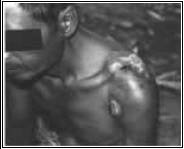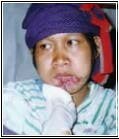 One of the greatest obstacles to assisting victims of torture and ending this abhorrent practice is public ignorance about the nature of the problem. One of the greatest obstacles to assisting victims of torture and ending this abhorrent practice is public ignorance about the nature of the problem.
Few people really understand what torture is. Since a greater awareness is essential for the prevention of future torture, I would like to explain what torture is, as well as its aims, methods and effects, drawing in particular upon the experiences of torture victims in Burma. The Tokyo declaration on torture, cited above, provides a basic definition of torture. Concerning the aims of torture, however, it mentions only the immediate reasons for inflicting torture and not the underlying purpose, which is to effectively destroy the soul of a human being. Torture is designed to break down the identity of a strong man or woman, turning a union leader, a politician, a student leader, a journalist, or a leader of an ethnic minority group into a non- entity with no connection on to the world outside of their torture chamber.
The process begins with arrest, usually at night. In Burma, however, sometimes this process starts in broad day light in public places. This was the case with the arrest of Min Ko Naing, one of the most prominent student leaders of the 1988 pro-democracy uprising. Min Ko Naing, now 38 years old, is the chairman of the All Burma Federation of Student Unions (ABFSU). He and I were arrested in front of many people by a group of men in civilian clothes on the afternoon of March 23,1989. Our arrest was violent-three policemen pulled our necks very roughly, as if we were dangerous criminals. Then we were turned over to agents of the Military Intelligence services (MI).
The MI men put handcuffs on Min Ko Naing and pulled a dirty hood over his head before taking him away in a truck. I and several other people witnessed the vicious beating he received as he was being dragged away to the truck. The MI agents kicked and punched him all over his body, then took him away to a secret destination where he was kept for several weeks and brutally tortured. His family was not permitted to visit him for nearly three years. They saw at once that he was suffering from physical and psychological trauma. Now, 11 years after his arrest, Min Ko Naing still languishes in Sittwe prison, far from his family in Rangoon.
In Burma, under the present military regime, various physical torture methods are being used, including systematic beatings (aimed at inflicting permanent injury), unsystematic beatings (using rifle butts, truncheons, etc.), electric torture (applying electrodes to sensitive parts of the body, such as the gums, ears, fingertips, and sexual organs) and "moe dewa", or water torture (drops of water fall onto the victim's head until, after a number of hours, they feel like a pounding hammer). Another common practice is burning victims with cigarettes. In the case of unsystematic beating, permanent damage may occur, even if that was not the intention. Thura Soe, a former political prisoner who was released in 1999, described being kicked and beaten by a group of men while being held at an interrogation center. The beatings started even before he was asked any questions.
Both of his ears were hit during this in discriminate beating, leaving his hearing permanently damaged. Later, his right leg, which had not healed from a previous injury, was repeatedly jumped on. Moe Aye, another former Burmese student political prisoner, described his experience of systematic torture in his book, Ten Years On: "Sit down, MI ordered, 'and stretch out your legs." "Then one of my legs was pulled up, and I felt terrified. Both of my legs were placed on a piece of hard wood, and I then felt something like another piece of wood being place on top and I heard the sounds of iron chains. It was extremely painful and I cried out loud." After being brutally tortured, the tissue damage and structural and functional consequences are the same as after assaults, accidents and sports injuries. In other cases, victims suspended by their wrists and with their arms above their heads, a common posture during interrogation by MI agents, complain of long-term joint pain, and some have difficulty standing or sitting for long periods of time. 
The physical forms of torture are very severe, but the worst form of torture is psychological. Mostly, psychological torture starts upon arrest. As soon as one is arrested, a dirty hood is placed over the head. One immediately looses all contact with the outside world. Then one is put into isolation in a small cell, which is kept either very dark or very bright. While under interrogation, one is not allowed to sleep, eat or drink for at least 36 hours. The victim loses all sense of time. Torture victims are not allowed to bathe for many days and are kept in very unsanitary conditions. When the detainee requests a visit to the toilet, the authorities turn a deaf ear. Under such circumstances, the torture victim may become abnormal, sometimes resulting in suicide.
Tin Tin Nyo, 26, a well-known female student leader, was detained and interrogated by MI in 1990. While she was in the interrogation center, she was kicked in her supra pubic region by MI agents wearing jungle boots. Further details of her torture are not known, because she refused to discuss them with anyone. Finally, on December 31, 1993, she succeeded in killing herself.
Physical and psychological forms of torture are often closely linked, leaving scars that are difficult to detect. Many victims will not dare to reveal their experiences of having their sexual organs violated as it is closely linked to shame and guilt and the fear of a social stigma when they are released. Many victims suffer from insomnia and nightmares long after experiencing torture. Severe depression is another common problem, often so debilitating that it becomes extremely difficult for the victim to return to normal life.
Public awareness can help prevent the future torture of unfortunate victims, as well as the nearly 2,500 political prisoners still inside Burmese prisons. Let's think how we can help the torture victims.
ABOUT THE AUTHOR OF "WHAT IS TORTURE" - Bo Kyi became involved in politics during the 1988 popular uprising in Burma. He is a former executive committee member of the All Burma Federation of Student Unions (ABFSU). He was released on October 2,1998 from Tharawaddy prison and he left Burma a year after his release. He is a joint secretary of Assistance Association for Political Prisoners (Burma)(AAPP) and lives in Thailand.
Courtesy of AAPP Website: https://www.aappb.org
|